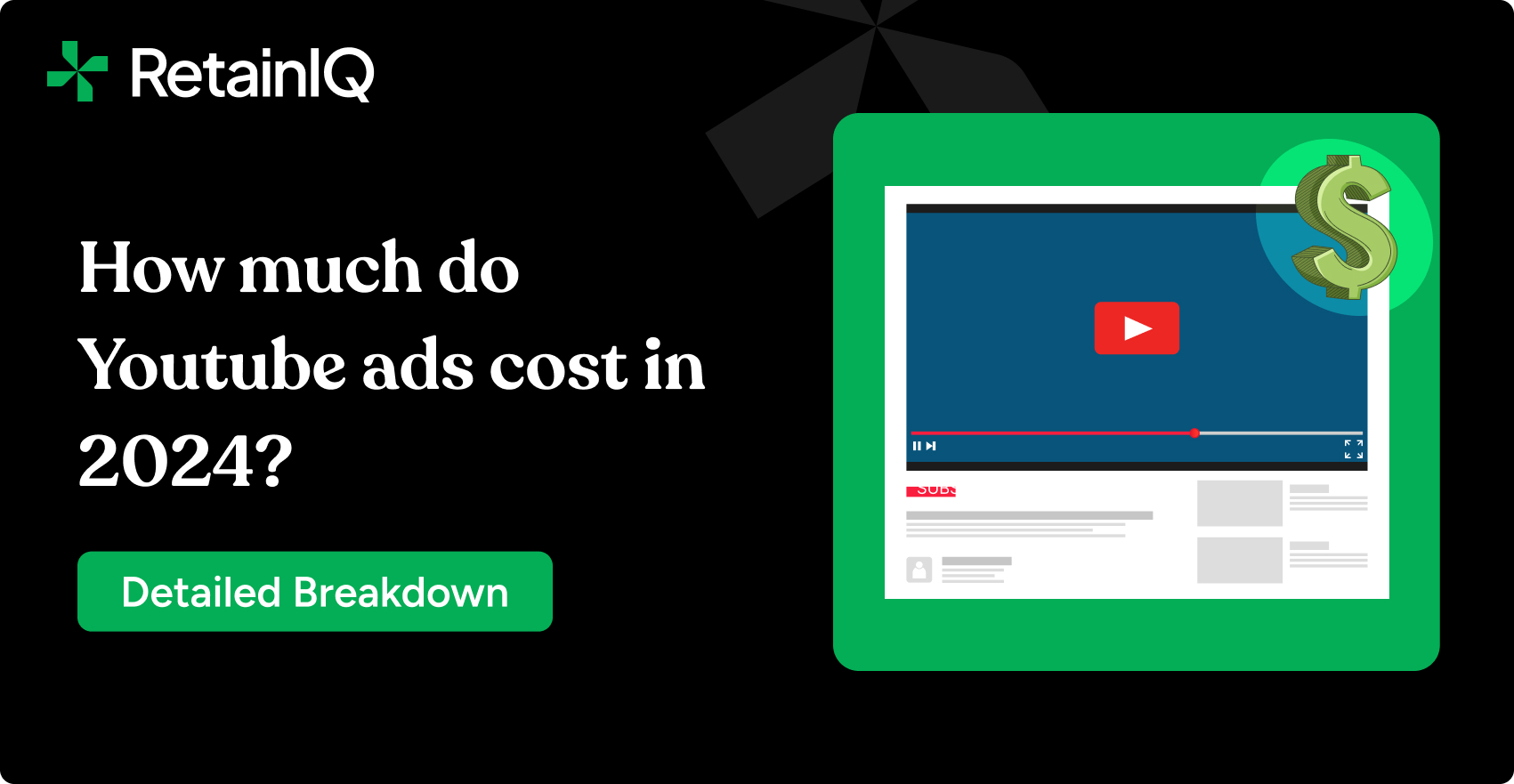Okay, be honest – how many times have you skipped a YouTube ad after the first 5 seconds? Probably a lot. But even when you do, you’ve already consumed the message. In fact, in a survey, 70% respondents said YouTube made them aware of brands they didn’t know of before.
So, even a skipped YouTube ad delivers value to the advertisers.
No wonders, YouTube ads are popular among all kinds of industries — right from skincare to SaaS.
Still, there are lots of questions about YouTube ads that are asked countless times on the internet.
Most of them don’t have simple one word answers.
For instance, people often wonder whether YouTube ads are too costly for them. The truth is, YouTube ads cost depend on many factors. For context, the industry average cost per 1000 impressions for YouTube ads is $20. That’s not the cheapest among social media channels. It all depends on what your ads are about, whom you’re targeting, what your conversion rates are, and many more factors (we will cover everything in more detail in this guide).
So, to clear the chaos we decided to write this comprehensive guide. We’ve done this with one goal: help you determine whether YouTube ads are beneficial for you.
In this guide, we will cover:
- A short summary of YouTube Ad costs
- How does Youtube Ad costing work?
- What factors affect the cost of YouTube Ads?
- Is it worth using YouTube ads?
- 7 best tips to optimize your YouTube ad campaign
So, let’s get on with it.
YouTube Ads cost: a short summary
Sure, you’re curious about Youtube ads cost in 2024.
It’s a tricky question with no one-size-fits-all answer. But here is an overview to prep you.
- Cost Per View (CPV): This is what most campaigns use. Expect to pay $0.03 – $0.30 whenever someone watches your ad for at least 30 seconds.
- Cost Per Thousand Impressions (CPM): Another option, where you pay around $4 – $10 for every 1,000 times your ad is shown. (Don’t worry if some of these terms aren’t clear to you; we’ll explain everything in due course.)
- Average Budgets: Most businesses start with $10 – $50 per day, but this can change depending on your goals.
- Don’t Forget Production Costs: Making great videos costs money! Factor in things like hiring a crew, equipment, and editing when budgeting.
- Other Stuff That Affects the Price: Who you target, your ad types, how you bid… these all influence how much you’ll end up paying.
A disclaimer here: don’t take those numbers as gospel. Youtube ads costs can fluctuate based on factors like:
- Your bidding strategy (more on that later)
- Ad placement and targeting
- Video ad length
- Your industry/niche
While this lack of certainty may be disconcerting, there is good news.
Nearly half of businesses allocate just 6-30% of their total ad spend to YouTube. And a solid 75% feel the ROI is worth it.
Of course, your mileage may vary. That’s why we also have a section on how to improve your CPM for YouTube Ads in this guide.
Now, we’re ready to dive really deep into Youtube ads costs.
How does Youtube Ad cost work out at the campaign level?
As digital marketers, we’re familiar with different pricing models for online advertising.
So let’s start from there.
These models can help explain how YouTube ads costing works. Let’s quickly refresh our memories on three common pricing approaches:
YouTube CPM Pricing
With this model, advertisers pay for every 1,000 times their ad is shown, regardless of whether viewers interact with it.
For YouTube ads, the average CPM falls between $4 to $10. So if you want 100,000 ad impressions, you could expect to pay around $400 to $1,000.
But your actual CPM can vary based on factors like:
- Video ad format (skippable in-stream, bumper, etc.)
- Targeting (interests, topics, keywords, etc.)
- Ad auction competition levels
- Your overall ad quality and relevance
To reduce CPMs (meaning you’re spending less for the same exposure), you’ll need to use targeting options that narrow your audience to more specific interests/demographics. We’ll explain targeting later in this guide.
For now, let’s compare the CPM model with the CPV model.
YouTube CPV Pricing
Here, advertisers pay each time a viewer engages with their video ad. On YouTube, a view is typically counted:
- after 30 seconds of watch time or
- if the viewer interacts with the ad or
- if the ad is of fewer than 30 seconds and the user watches it completely.
For YouTube, the CPV pricing generally ranges from $0.03 to $0.30 per view. To get 100,000 views, you might pay anywhere from $3,000 to $30,000 depending on other factors.
YouTube’s CPV model charges you each time a viewer watches 30 seconds of your ad (or the full duration if ad duration is <30 secs). As a benchmark, CPVs range from $0.03 to $0.30 across most industries.
However, CPVs can be impacted by audience targeting, video ad quality, and competition levels – just like CPMs honestly.
YouTube CPC Pricing
With this pay-per-click model, advertisers are charged each time someone clicks on their ad. While common for Google Ads campaigns, YouTube does not use CPC pricing. Instead, costs are based on CPV or CPA (cost per action) metrics.
Before we go ahead, here’s a summary of YouTube ad pricing.
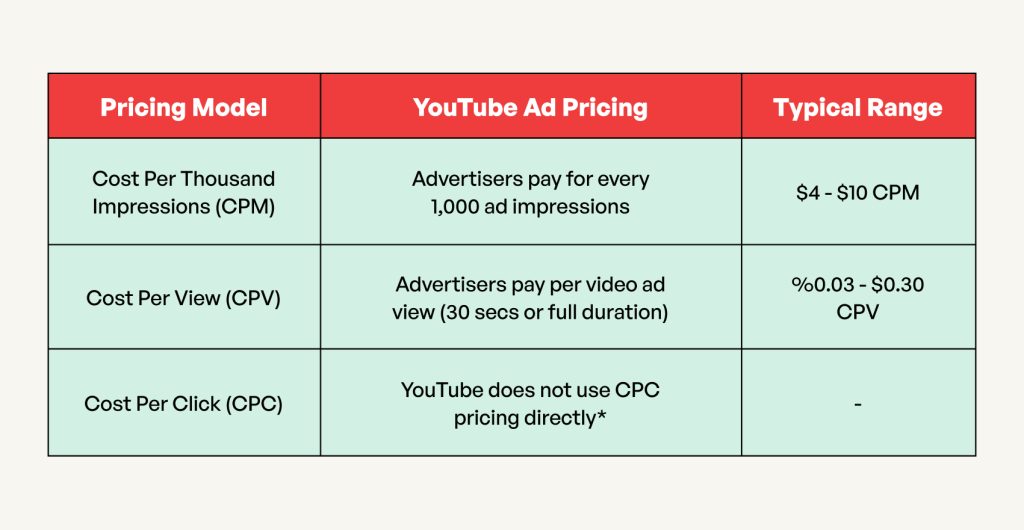
Where does this leave us? It’s clear that the general CPM and CPV ranges give you an idea of YouTube ads cost. However, the numbers could change significantly for your industry.
To give you a sense of average CPM and CPV numbers for different industries, here are a couple of useful tables.
Average CPV for YouTube Ads For Different Industries
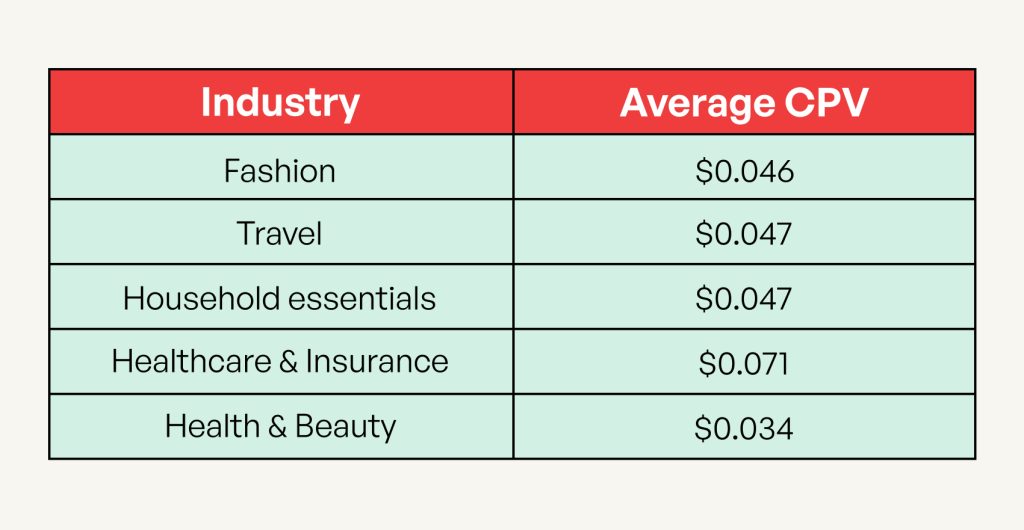
Average CPM for YouTube Ads For Different Industries
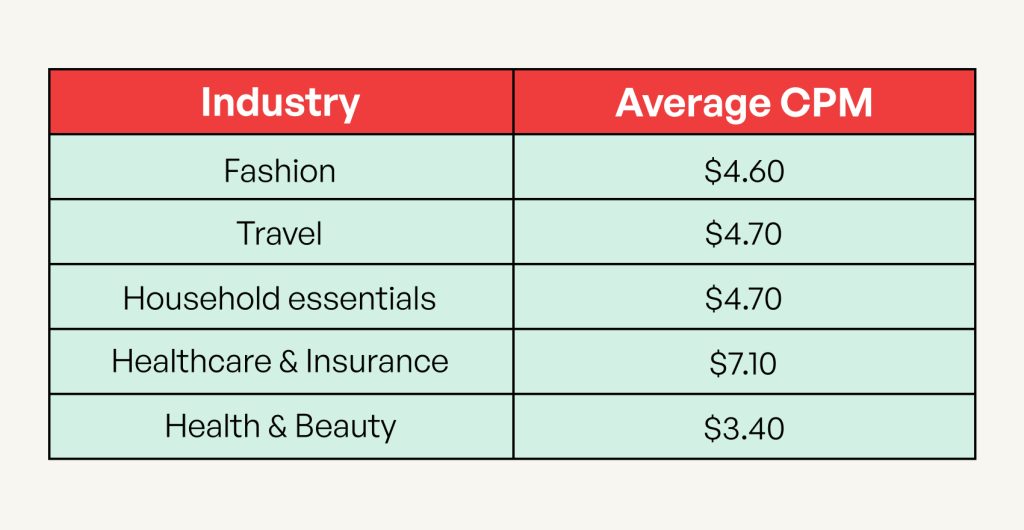
Note: The industry is only one of the variables that can push your average CPV and CPM higher or lower than industry averages.
The optimal pricing for your campaigns depends on so many other factors. Details like ad creative, audience targeting, and YouTube ad placements matter a lot.
Let’s explore some of these factors that influence whether it is worth using YouTube ads for you.
What Factors Affect the Cost of YouTube Ads?
Okay, so we know YouTube ads cost less than you think…but what exactly determines that price tag? There are a few key players:
- Ad Format: How your ad shows up makes a difference in price.
- Bidding Strategy: It’s an auction out there, so be prepared to play the game.
- Targeting Options: The more specific your audience, the more you might pay.
Let’s explore all these factors in a bit more detail…
YouTube Ad Formats and Their Impact on Costs
YouTube provides several different video ad options. Each of these options have their own pricing implications that everyday advertisers should understand.
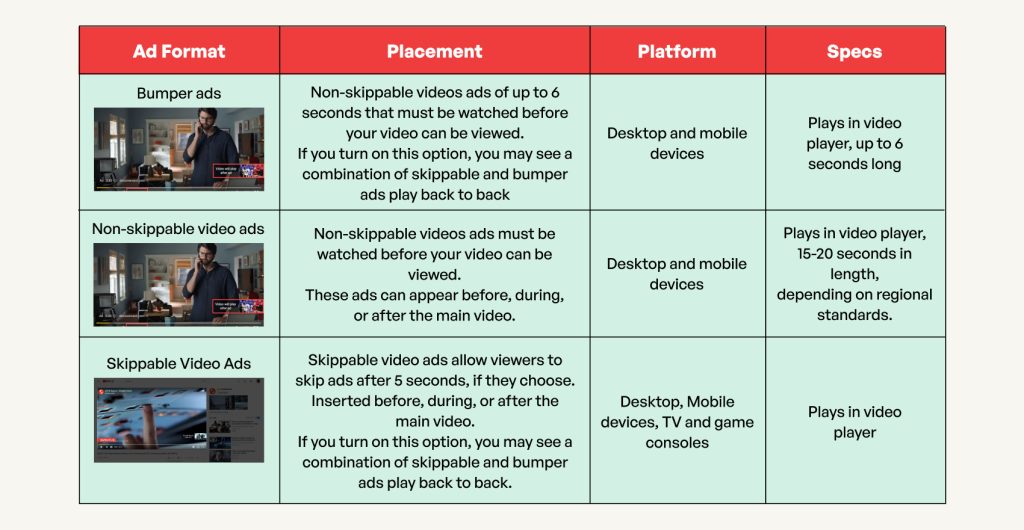
Let’s break down the main YouTube ad types:
- Skippable Video Ads These are the ads that play before, during, or after the video you want to watch on YouTube. The main thing to remember about these ads is that viewers can skip these ads after 5 seconds. Naturally, skippable video ads tend to be on the lower end of the YouTube ads cost spectrum. You only pay if viewers watch at least 30 seconds or engage with your ad.
- Non-Skippable Video Ads As the name implies, these pre-roll, mid-roll, or post-roll ads (typically 15-20 seconds) cannot be skipped. That’s the good thing — viewers must watch before their video. The forced viewability makes non-skippable ads more expensive in terms of YouTube ad costs. However, you know your whole message is delivered to the viewer.
- Bumper Ads Bumper ads are very short non-skippable videos, maximum 6 seconds long. While more affordable for YouTube ads cost due to their brevity, bumper ads offer little time to tell a complete story. They work best for focused product/brand visuals.
The ad format you choose should align with your campaign goals, audience, and overall budget.
- Non-skippable ads have higher YouTube ad costs but guarantee ad delivery.
- Skippable ads are cheaper but rely on an engaging message.
- Bumper ads are ultra-affordable but fleeting.
Ultimately, you’ll want to test different ad formats. Only then can we understand which ads drive the best performance.
How Bidding Strategies Impact YouTube Ads Cost
The bidding process is another key factor that determines your overall YouTube ads cost. Let’s get to know it better.
Similar to Google Ads, YouTube uses an auction system. In this system, advertisers bid against each other for ad placements.
Your bidding strategy plays a major role in both the cost and delivery of your YouTube ads. Here’s a quick overview of how it works:
- YouTube ad auctions allow you to set a maximum bid cap based on your target cost-per-view (CPV).
- This is the highest amount you’re willing to pay each time a viewer watches 30 seconds of your video ad (or the full duration under 30 seconds).
- The more you bid, the higher priority your ad receives for premium placements across YouTube.
- A higher bid gives you an advantage over competitors going after the same target audience.
- However, bidding higher amounts also depletes your daily budget faster.
- You may get more valuable impressions initially, but your ads will stop running sooner once that budget is drained.
- On the flip side, bidding lower CPV amounts results in losing the auction more often to higher bidders.
- While extending your budget’s lifespan, your ads may show up less frequently or in less desirable ad placements.
So, is there a clear formula here? Nope. There’s no one-size-fits-all optimal bidding strategy.
The right approach depends on your specific goals, audience, and how your ads perform at different bid levels. Test, test, and then test some more.
How Targeting Impacts YouTube Ads Cost
The targeting options you select for your YouTube ads influence your overall campaign costs.
Let’s look at some of the main YouTube targeting types and how they impact ad costs:
- Affinity Audiences
These allow you to target viewers based on their passionate interests, habits and habits. More niche interest categories tend to have higher YouTube ad costs due to increased competition for those valuable audiences.
- In-Market Audiences
You can target viewers who have shown recent purchase intent and are actively researching products/services like yours. These high-intent audiences understandably come at a premium cost.
- Custom Audiences
Build a tailored target audience using specific keywords, URLs, apps, and other signals. Highly customized audiences tend to be smaller but more targeted, raising ad costs.
- Demographics
Standard demographic targeting like age, gender, parental status, etc. is relatively cost-effective as these are broad audience pools.
- Customer Match
Leverage your own first-party CRM data to re-engage existing customers on YouTube. Incredibly targeted but could have limited reach, impacting costs.
The more specific your targeting criteria, the higher the YouTube ad costs are likely to be. However, you’re also increasing the relevancy for your ideal audience.
What does this mean for you?
A single targeting factor can double your average CPM or halve it. For instance, while the average CPM for YouTube Ads is $20, the number soars to $32 for the USA, and $38 for Germany.
So, your actual campaign costs will become obvious only when you actually set the targeting up.
The right targeting strategy finds the sweet spot between affordable reach and precision. This means you have to test combinations of targeting.
Note: Apart from the three factors we discussed above, there are other factors that could influence YouTube ad costs. These factors aren’t controllable at the advertiser’s end. For example, seasonal trends could increase your ad costs.
Impact of Seasonality on YouTube Ad Costs
Just like prices at the store can fluctuate, the cost of YouTube ads isn’t always the same. Big shopping holidays around the world, like Black Friday, Cyber Monday, Christmas, New Year’s, and even Singles’ Day in China, create periods of heightened online activity. During these times, competition for viewers’ attention skyrockets. As a result, the cost of advertising on YouTube goes up. But here’s the good news: more people are shopping online during these peak seasons. So even though your ad might cost more, you’ll likely get a lot more views, clicks, and even sales – because people are actively looking to buy.
Is it worth using YouTube ads?
This might be the most important question you ask us. To answer this, we need to compare YouTube Ads versus other channels.

So, is YouTube Advertising more expensive or less as compared to other channels?
When you compare YouTube ads cost versus other marketing channels, look at the bigger picture.
Begin by revealing the true cost of YouTube Ads. For this, you need to consider all the less obvious and hidden costs.
For great results, you need great ads.
To create great video ads requires production resources – whether you use an agency or invest in equipment/editing capabilities in-house.
This adds to the overall YouTube advertising costs.
Alternatives like Meta (Facebook/Instagram) ads have lower entry costs for ad creative. Why? Because static ads or video ads with basic motion graphics work well on Meta. These assets are less expensive to produce compared to videos.
That’s not all. Why restrict yourself to social ads? Think on a holistic level.
Email marketing can be even more cost-effective for customer acquisition and retention when done correctly. With relatively low overhead, email allows you to continuously nurture leads and customers.
Next question…
What CPM/CPL is considered good for YouTube ads?
We’re asked this question many times. Always, the answer is a bit of a dampener: there is no right answer.
We know that the average CPV for YouTube ads is $0.30 and average CPM is $20.
But should you benchmark against the average?
No, its better to compare your numbers with industry-standard YouTube CPM if you can find the data for your industry, and then hope to be within the 75-80% range of it. That’s a good start.
So, the cost of YouTube advertising shouldn’t be evaluated in a silo. Think in terms of an advertising mix.
Combine different ad channels like YouTube, Meta, email, and others based on your business goals. YouTube video ads are expensive but worthwhile top-of-funnel investment for driving buzz and awareness. While lower-funnel tactics like email marketing nurture those prospects toward conversion.
Is YouTube Advertising Right for Your Business?
Deciding if YouTube ads are a good fit isn’t always straightforward. It depends on factors like your target audience, marketing goals, competitive landscape, and available resources.
Let’s break it down:
Target Audience Alignment
Where does your ideal customer spend time online?
If they are active YouTube users – watching videos for entertainment, education or research – advertising on the platform aligns well.
However, if your audience gravitates more toward other video platforms or social media channels, YouTube may not be the best option.
Brand Goals
YouTube excels at increasing brand visibility and awareness. That’s important, because its global scale means you can get your brand in front of millions. So, to build brand recognition, YouTube is extremely valuable.
Competitive Landscape
Take note of your major competitors. Are they investing significantly in YouTube advertising? If so, you may need to establish a strong YouTube presence to keep pace. That’s how you’ll find an opportunity to outmaneuver them on the platform.
Budget and Resources
YouTube ads require a budget for both media spend and video production. Ensure you have the flexibility and creative resources to develop great ads.
So, let’s ask ourselves the question once again: How are YouTube ads beneficial for your business? These examples can help you answer for yourself.
- A new niche product startup with limited funds may not justify heavy YouTube ad investment early on. Organic community building could be a higher priority.
- An established brand launching a major new product may view YouTube as essential for rapidly driving mass awareness.
- A thriving B2B SaaS company consistently generates leads through targeted YouTube campaigns aimed at their buyer personas.
What Percentage of Your Advertising Budget Should You Spend On YouTube Ads?
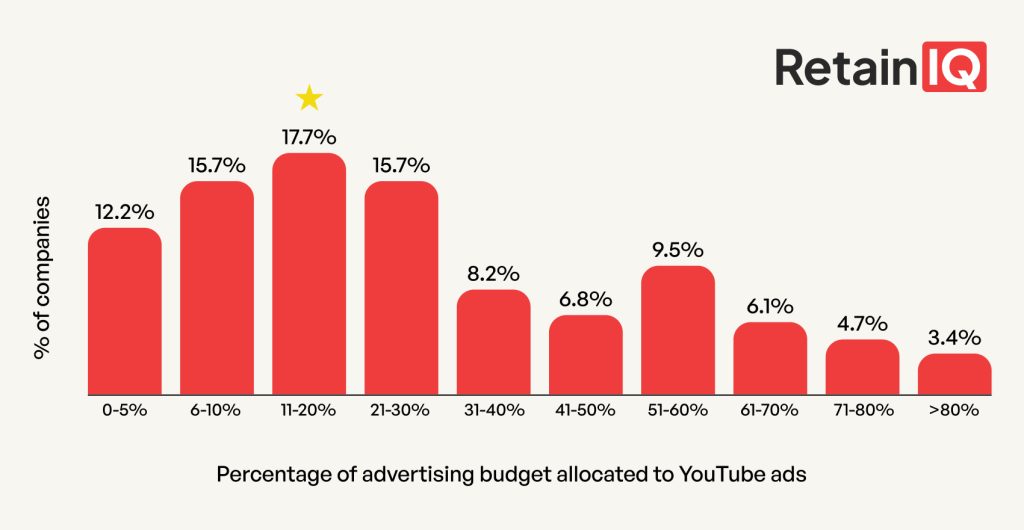
Most businesses find success allocating 6-30% of their total marketing budget to YouTube ads.
To determine what’s right for you, ask yourself:
- Does my target audience actively use YouTube?
- Will YouTube ads support my current marketing priorities?
- Are my competitors crushing it on YouTube?
- Can I produce high-quality video creative consistently?
- Do I have enough budget flexibility?
- At what percentage of budget does YouTube advertising become cost-effective for me?
- How will I measure and optimize performance?
- Are there alternatives that could be a better fit right now?
- How does YouTube fit into my overall marketing mix?
- Am I prepared to constantly test and iterate my YouTube strategy?
There’s no universal right or wrong answer. You’ve got to know what you have, and what you want, to know how much to invest in YouTube Ads.
Remember; it’s common for advertisers to feel disappointed after their first YouTube campaign because they don’t anticipate the steep learning curve. It’s not the end of the road. You can boost you YouTube Ads ROI.
How? Read on.
7 best tips to optimize your YouTube ad campaign
These simple tips can elevate your YouTube ad campaigns from good to exceptional.
1. Invest in Creative
Research indicates that stellar creative accounts for nearly half of your ad’s return on investment (ROI). Think beyond basic ads and strive for content that stands out. Google’s ABCD principles offer a framework:
- Attention: Grab viewers instantly with eye-catching visuals or an intriguing hook.
- Branding: Clearly integrate your brand in a way that’s memorable, not intrusive.
- Connection: Build an emotional connection or spark interest through relatable stories.
- Direction: Include a clear call to action viewers can act upon.
2. Find The Most Suitable Ad Formats
Different YouTube ad formats serve specific purposes. A full-funnel approach consistently outperforms focusing on awareness or action formats alone. Consider these for a balanced strategy:
- Awareness formats: Gain broad exposure with options like skippable and non-skippable in-stream ads.
- Consideration formats: Influence research and interest with discovery ads.
- Action formats: Drive conversions with bumper ads.
3. Optimize Reach and Frequency
Finding the right balance between how many people see your ad (reach) and how often they see it (frequency) is key. Generally, increasing reach maintains ROI while overdoing frequency can diminish effectiveness. Aim for a frequency of up to three exposures per week. Of course, this depends on your audience and goals.
4. Precision Targeting is Key
Showing your ads to the right people is crucial for results. Leverage these targeting options:
- Demographic: Reach viewers based on age, gender, location, and more.
- Interests and Behaviors: Align your ads with user’s passions and online habits.
- Custom Audiences: Target those who’ve already interacted with your brand.
5. Expand Your Placement Strategy
Consider these channels to amplify your reach:
- Channel sponsorships: Partner with relevant creators.
- Search results: Appear in searches related to your products.
- Influencer collaborations: Work with creators to promote your brand organically.
6. Test, Test, and Test Some More.
Continual testing leads to success.
Experiment with:
- Ad variations: Test different calls to action, visuals, copy, and lengths.
- Targeting: Refine your audience segments based on performance data.
7. Integrate With YouTube Ads
YouTube advertising integrates with Google Ads. This means you can plan your campaign across video and search. Google’s wealth of tools and insights can optimize your campaigns significantly.
The Final Take
YouTube’s popularity continues to soar, with its massive user base offering incredible reach. Video allows you to weave rich stories and connect with viewers on a deeper level. However, the marketing landscape isn’t a one-size-fits-all situation. The question shouldn’t be “how much should I spend on YouTube ads?” but rather “is it worth using YouTube ads?”
For some brands, a heavier focus on email marketing might be the smarter investment. For others, Meta ads with their sophisticated yet user-friendly interface might be the better fit. If you’re still making up your mind, we can help. Ask us for a free consultation.
Ultimately, the best advertising strategy depends on your unique goals and target audience. Regardless of your chosen path, we hope this guide has equipped you with the knowledge to make informed decisions and navigate the exciting world of YouTube advertising!

